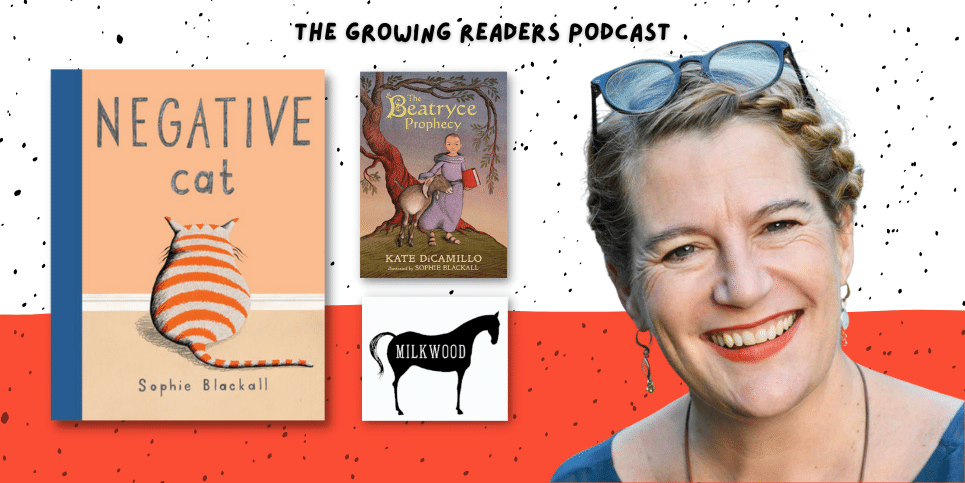An interview with Sophie Blackall
The Children’s Book Review
In this episode, I talk with Sophie Blackall, the two-time Caldecott Medal-winning illustrator of over forty books.
We discuss many amazing things, including her new creative retreat for the children’s book community, Milkwood Farm. We also talk about her artwork for two-time Newbery Medalist Kate DiCamillo‘s The Beatryce Prophecy (this book is A-mazing). The podcast community joins in the fun and asks Sophie questions, too. But to kick things off, we focus on her latest solo picture book, Negative Cat, a winning tale about Max, a feline whose behavior doesn’t win any raves, except from the boy who believes in him and finds a way to turn a negative into a positive.
Listen to the Interview
Read the Interview
Bianca Schulze: Well, hello, Sophie, welcome to The Growing Readers podcast. I’m so excited to talk to you today about Negative Cat. To be honest, I have so many questions for you so we could talk about a gazillion of your books, but we’ll focus on Negative Cat. And I also want to speak to you about The Beatryce Prophecy by Kate DiCamillo, for which you have created the gorgeous artwork. And we’re also all dying to know about Milkwood Farm.
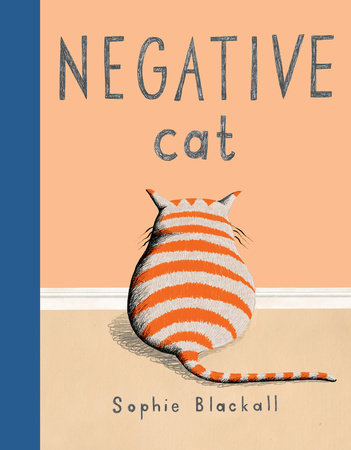
Sophie Blackall: Thank you, Bianca. It’s so lovely to talk to you again. It’s been a little while.
Bianca Schulze: Yeah, it has! To be honest, I’ve been following you on Instagram and I love how much you share there. You give us a little sneak peek of your life. You can tell me if I’m right or wrong, but, as people say, you wear your heart on your sleeve, I feel like you wear your heart on your Instagram feed. It feels honest to me because everybody’s had kind of a rough year and a half. You know, obviously because of Covid. But, you know, you’re real. You share your ups and your downs. And I know that you’ve had loss and lots of love and you share the connections you make and your creativity. And you also share things about sweet potatoes.
Sophie Blackall: Oh, well, thank you. That’s a very nice thing to say. I, you know, like a lot of people, I think I’m still wrestling with social media and trying to figure out how exactly to do it because it can be all-consuming. And, of course, like everybody, what we see and what we choose to present on social media is not the full story and not our full lives. And it would be weird if it were. So, there’s a lot of editing that goes on. And I don’t show you the shameful cascading piles of paper on my desk, because you know, that whole side of being a professional person, it just sort of slipped me by. So, there are so many parts of my life that I choose carefully not to show people—for your own benefit—because you really wouldn’t want to see it. But I hope that the things that I do show are honest. So, thank you for saying that.
Bianca Schulze: You’re welcome. And so, before we talk about Negative Cat, you can tell me if I pronounce this name wrong; I know people are wondering how Phillip and Shermaldine are?
Sophie Blackall: Shermaldine. The name is taken from Virginia Woolf’s Orlando. Here’s a spoiler alert. Orlando falls in love many, many times throughout the book. But ultimately, Orlando’s great love is Shermaldine, which happens right towards the end of the book. And it’s such a perfect love story that I just lifted Shermaldine completely from Orlando, which is one of my favorite books.
Bianca Schulze: I love it. So, Phillip and Shermaldine, for anyone that does not know this pair, you can go to Sophie’s Instagram feed. She has some lovely sweet potatoes that are married, and I believe they’re moving on to the next phase of family life. Is that correct?
Sophie Blackall: Yes, they are. So very, very quickly, early in the shelter at home, lockdown, quarantine, part of the pandemic last April, I guess, 2020, when we were all just wondering what on earth was happening to the world and we couldn’t go out. I went, like many people, to do a big shop on my own at the supermarket. And there was one sweet potato left in the store. And it was a time where I found social media to be actually a lifeline of sorts. It was how we could all connect and share our experiences. And I started to tell the story of the sweet potato, who I named Philip. Because I have a child who is gender fluid and my father was really wrestling with the ‘they’ them’ pronouns, which Olive uses. I decided to make Philip also a sweet potato who uses ‘they’ ‘them’ pronouns as a way of telling the story and using them in context. And hopefully, for other people who find that just a little bit new and a little bit confusing to put in a sentence sometimes, that might also be helpful for them.
So that was how it started. And it became a daily post of building this entire story around Philip the sweet potato and making them clothes and scenes. And then they had a love interest and, as you said, eventually a wedding. It was amazing to me how it took on a life of its own, this story. For the wedding, I invited people on Instagram to show up with their own wedding guests, perhaps from the vegetable drawer in their refrigerator or the fruit bowl, and make wedding outfits for them. And the photographs were incredible. I think I still have some in my Instagram highlights, but they came from all over the world. And it was clearly something we all needed to do in that particular moment … was to make clothes for our vegetables. Who knew? But it is going to be a book. You’re the first person to know.
Bianca Schulze: Oh, my gosh. That’s amazing.
Sophie Blackall: Also, the publishers who will make this book know, which is Abrams. So that’s a fun thing. So, Philip will live on.
Bianca Schulze: Well, we don’t want any spoilers, so we won’t ask any more questions. Your creativity shines. And I love that. And it’s so inspiring.
Let’s talk about Negative Cat because it’s such a creative story in the sense that I think readers can take different things away from it. The Children’s Book Review is all about growing readers and finding the next best book that will inspire kids to keep on reading. Negative Cat I love it because there’s a theme in there that there’s a boy who’s a struggling reader. And towards the end of it, there’s an encouraging message of reading. And I don’t want to tell everybody about it. I want you to tell everybody about Negative Cat and why they’re going to love it.
Sophie Blackall: Oh, OK. So, talking about struggling with reading, I was struggling with writing this book. I came up with the idea years and years and years ago. I think it took about ten or even 11 years for this book to gestate and finally come into the world as a fully formed story. And part of it was we adopted a cat, a kitten from a shelter, when my kids were little. And we named her Claudia after the character From the Mixed-up Files of Mrs. Basil E. Frankweiler, which is a favorite book of mine as a kid. And my children loved it as well. One of those joys of sharing books that you loved with your own children, or somebody else’s children, but that passing down of beloved books is one of the joys of life, I think.
Anyway, we named her Claudia, and she grew into what my son came to refer to as a negative cat. Claudia was not the kind of cat who greets you when you come home by rubbing against your legs and purring and jumps into your lap. Those are the things that other people’s cats do. No, Claudia was the kind of cat who, when you came home, would look at you over her shoulder and just go in and kind of grimace, really, and continue staring at the wall.
She would eat the flowers out of the vase. She would lie on top of the very thing that you were trying to read or work on. She would demand to be fed and then throw up in the vestibule and then demand to be fed again and complain that she was neglected and hungry. She was a lot of work for very little reward. But we loved her nonetheless, especially the kids and especially my son Eggy, who loved her so much, he would try and pat her, and she would scratch him. He would not give up. This was truly unconditional love. And eventually, she did become a sweet cat.
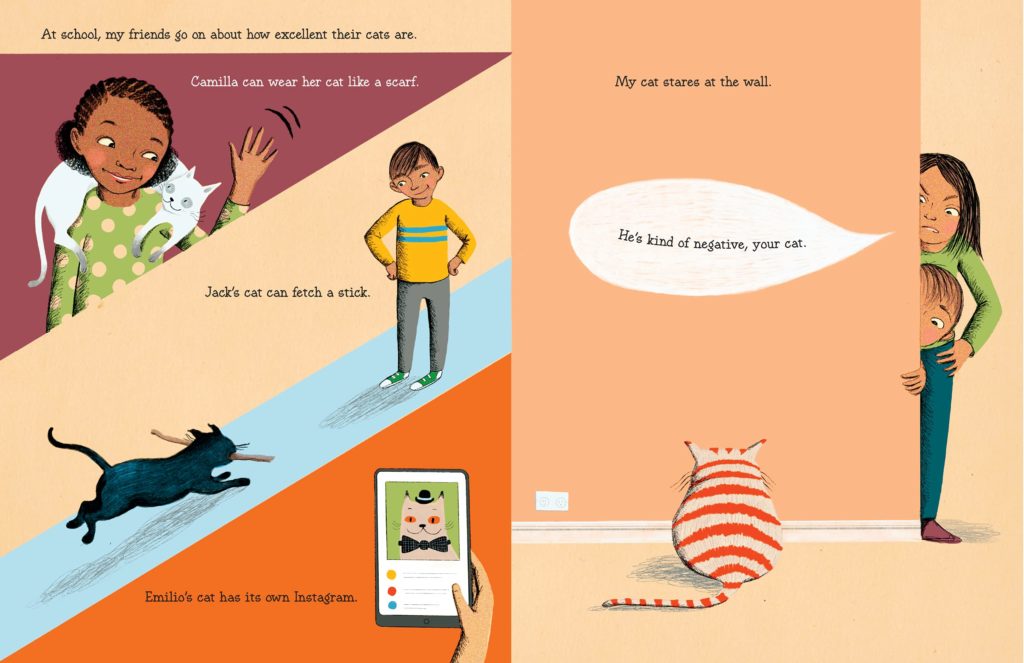
But anyway, I had this story in mind of a child who loved a basically negative cat, but I couldn’t end it. I tried so many different things and they were all lousy. And eventually, I just thought, I’m going to have to give up, you know, to give back my advance on this book. It’s not happening. And then I read about something happening at the Animal Rescue League of Berks County in Pennsylvania. And what was happening there was that kids were reading to the cats in the shelter.
It happened because one of the people who worked at the shelter had her own child who was not coming along with his reading the way he wanted. He was finding it frustrating, he was getting stuck, and he stopped even wanting to do it. Which I think is a familiar experience for a lot of kids. And so, she suggested he came in after school in the afternoon when she was working and sit down and practice reading with cats. And the cats are entirely nonjudgmental. And they would sidle up to him and he would read through these books.
Some photographs accompanied—I think it was a blog post from the shelter where I first read about it—and they were just so endearing and heart-melting these pictures of children. It grew to be something many kids could do as an after-school program, children reading to cats. And you could just imagine what a rewarding experience that was. And so, I suddenly had my ending for the book. This is how the cat redeems itself and this is how the child overcomes his struggling with reading. And since then, I visited other shelters and spent time in one that’s closer to me in upstate New York and hung out with the cats in the room. And it’s a fantastic experience.
Bianca Schulze: I love that, Sophie. Honestly, I think that’s why I have enjoyed reading Negative Cat so much. Because, well, on the one hand, I feel like as an adult, as a parent of three kids, and that burning question of can I have a pet, can I have a pet? Whether it’s a dog or a cat or a guinea pig or a rabbit. That’s how Negative Cat starts; the boy really, really, really wants his cat. So, I feel like that’s a relatable part of the story.
And then you get that animal and maybe that animal doesn’t have the personality you think it will have. You know, like the cat is just staring at the wall. It’s doing all of these kinds of things that you wish it didn’t. And I feel like anyone who’s owned a pet can relate to that.
And then the reading part, which is close to my heart, just seals the deal. So, I love the way you found the ending of the story. And I just love the way it has multi appeal—it’s why so many different readers will enjoy it.
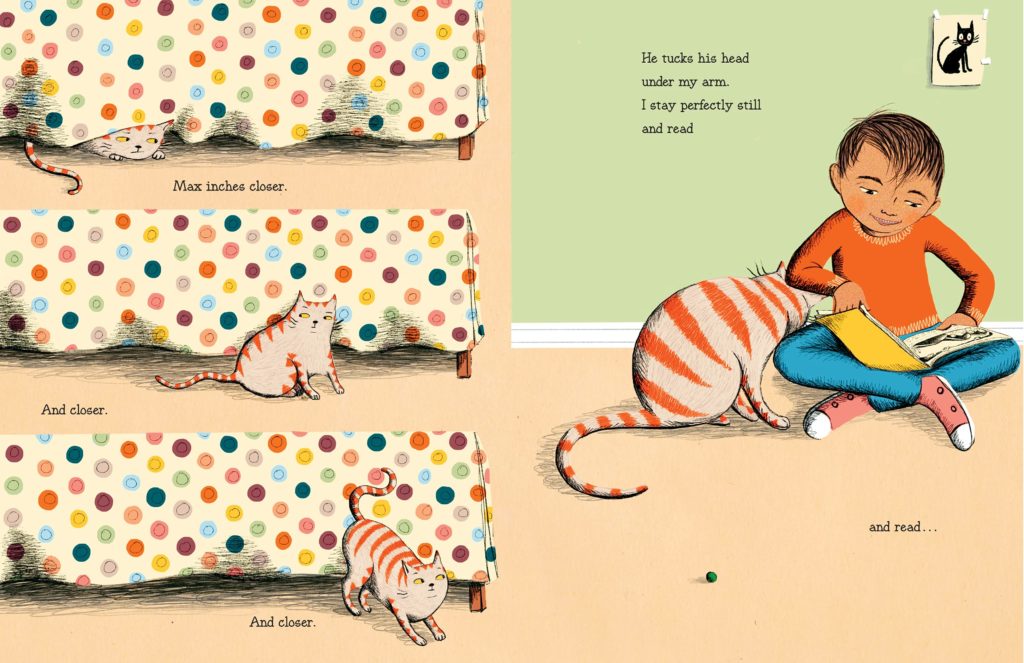
Sophie Blackall: You know, some books and stories are like that. They come when they’re ready. And I believe in that as a reader as well. I think we often find the books we’re meant to read at the time we’re meant to read them. One of my favorite books in the world is Moby Dick. I had access to Moby Dick for my entire life, but I didn’t read it until I was about 35. And before then, I had just resisted it. And then I picked it up and it was such a joy. But clearly, I wasn’t ready for Moby Dick before then.
So, I think with kids, just to try our best to give them access to books. And however, that happens—there are many wonderful ways that can happen, local libraries and mobile libraries and classroom libraries and having books around the house. And, of course, some of us have more access to them than others. But there are so many people working around the world to make sure that every child can have access to books. That’s very inspiring.
Bianca Schulze: Absolutely.
The illustrations, of course, are incredible. I have to say; I feel like my favorites might be kind of unique. I love the cat scene where the cat is staring at the wall. I just find that hilarious. And then this is random; I just loved that you included the little illustration of poop and the little bit of steam that’s coming off the poop.
So, I’m going to ask you, as the artist, was there a particular spread that you enjoyed creating?
Sophie Blackall: I had so much fun with this book. It came on the heels of another book that took a very long time, If You Come to Earth, that came out last year. I spent seven years on that book and there was so much research in those illustrations. It was a true labor of love. Whereas this story took a long time to finally bloom, but the drawings were just joyful. I just had so much fun with them. And I think that was just partly the timing. It was partly the story matter.
One of my favorite books as a kid and another book that I love sharing with my kids was The Happy Lion. It’s by Louise Fatio and illustrated by Roger Duvoisin, who’s one of my favorites. And I hadn’t thought about it in a while. I looked at those drawings—The Happy Lion is kind of the opposite of the Negative Cat—and I started going down this whole rabbit warren of finding old Duvoisin books on eBay, and he was very much an inspiration for these drawings.
But one of the things I loved doing was making up the kids’ drawings of cats. For a while, I was begging any child near me, can you draw me a cat? Like, how do you draw a cat? Inspired by all of those kids’ drawings of cats, I made a lot of the artwork that the child does in the book based on those drawings. And in the end, all the kids who come to the shelter to read to cats, of course, fall in love with the cats and beg their parents for their own cat in a sort of bookend way of how the story starts. And they’re all drawing pictures of cats.
And so that was probably the most fun for me to make up those because they’re completely individual, and they relate to each child the way that they would possibly draw their cat. One kid is really good at shading and is drawing a cat with a biro pen. And it’s taken him a really long time. And other kids have just dashed off their cat. Drawing with kids is something I miss so much since we’ve been unable to be gathering in that kind of way. And I look forward to that again, going to schools and doing art workshops with kids.
Bianca Schulze: Oh, my gosh. I would love to be a kid in one of your workshops. That would be amazing.
So, I noticed, and you did the same for If You Come to Earth, as you did with Negative Cat, where you posted on Instagram a piece of the artwork from the books. And so, for Negative Cat, there’s a shelter scene where all the cats are in their crates and there are little blank spots for what the cat’s names are going to be. And you pose it to your book-loving community: Could you help me name these cats? And for If You Come to Earth, it was to name paint colors. I love that you do that, that you invite your readers in to help participate. On the actual release day, you’re going to announce whose names you picked for the cats.
Sophie Blackall: Correct. Yes. And they were such great names, and it was so hard to whittle it down to 16. Pookie is the name on the cage that is the cat that is being adopted. And they rename the cat Maximilian Augustus Xavier, and we will call him Max. So, I had the remaining cats to name, and it was difficult to whittle them down. And eventually, I had to ask my whole family for help. And we voted on them and had shortlists—it was one of the most time-consuming parts of the whole book was naming these cats. So, I look forward to making the grand announcement of which names were chosen.
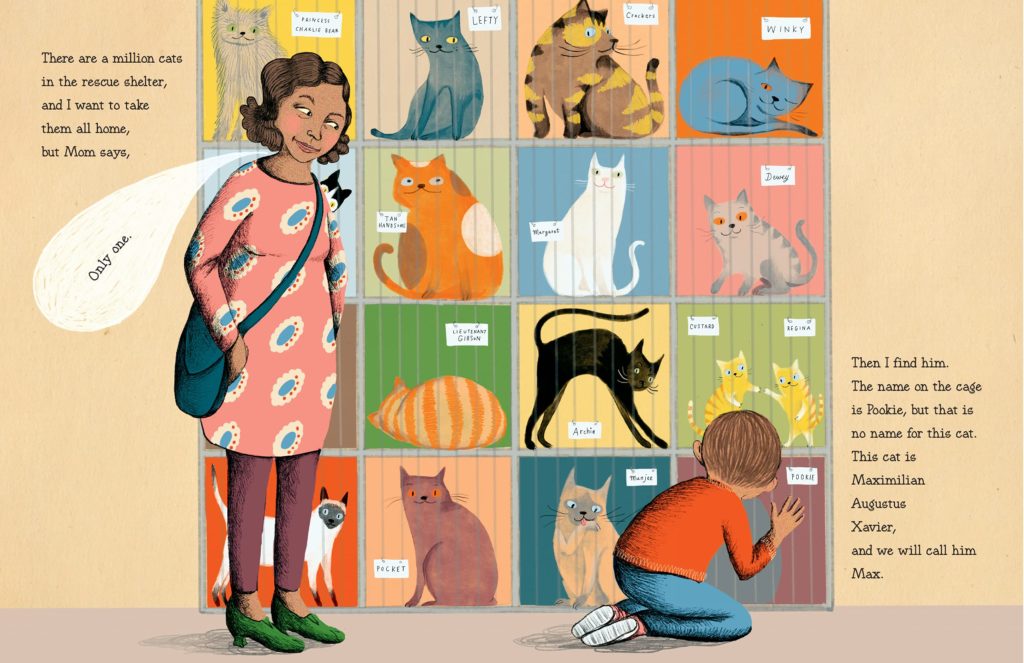
Bianca Schulze: That’s fantastic. So, I love that Negative Cat really embraces my mission of growing readers and fostering that love of reading. And so, I want to segway into the artwork that you’ve created for The Beatryce Prophecy by Kate DiCamillo because, again, there is a reading theme.
I have to say; I’m about just over a third of the way through reading it. And so, it might be too soon to say, but I feel like this might be my favorite Kate DiCamillo book. I’m going to read the first little page here. It says:
It is written in the Chronicles of Sorrowing that one day there will come a child who will unseat a king. The prophecy states that this child will be a girl. Because of this, the prophecy has long been ignored.
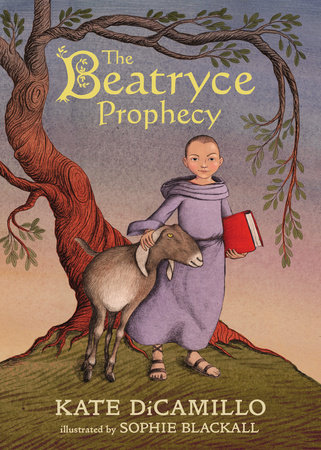
When I first read it, I was like, I’m going to love this book. And then Beatryce herself is a girl in times where girls are not supposed to read or write.
Sophie Blackall: In times where really only noblemen are allowed to read.
Bianca Schulze: I believe this to be true from your illustrator’s note that is in the back of the book, you had your coat on, you were ready to walk out the door, this manuscript came in, you took off your coat, and you sat down and you read. And so, I’m wondering for you what it was about The Beatryce Prophecy—besides the fact that it’s written by Kate DiCamillo—how did you know you needed to create the artwork for this book?
Sophie Blackall: Right. Well, even just what you read then gave me goosebumps and you read it very beautifully. That was exactly what happened. I mean, you can well imagine. If somebody had sent me an email saying, would you like to illustrate a book by Kate DiCamillo, I would have said, yes, I don’t need to read it. Yeah, sure. Absolutely. I’ll drop everything; let’s do it because I am a huge fan. But I thought I would just begin to read this. I will stand by the door with my coat and bag over my shoulder because I am running late, and I have to step outside. And I’m just going to read the first few sentences. And I got goosebumps.
I stood there and I read and then I put my bag down and then I took my coat off. And then I actually sat down on the couch that I very, very, very rarely sit down on, because who has time to sit down on a couch? And I read the whole book. I canceled my things I was going to do. And I sat and read it, read it from beginning to end, and then pretty much wanted to read it again. It’s the kind of book that you simultaneously feel you have always known. Somehow it feels like an old story that is deep in your bones. And it feels like you are not really meeting these people for the first time but revisiting old friends.
I just loved spending time in that world, even though it’s a world in which lots of bad and dangerous and sad and troubling things happen. There is this light of hope and joy and overcoming obstacles and friendship and love and forgiveness and all of these things that Kate does so beautifully and mesmerizingly, leaving us with this story that really does feel like we’ve known it forever. It was a joy.
Bianca Schulze: Yeah. Do you know what’s funny? As I’m reading, I take lots of little notes. One of my notes is familiar yet fresh. Because it’s what you said, you feel like you know these characters, that you’ve read them before. But yet the story is new.
Sophie Blackall: Yeah, because they’re so vivid. They’re so incredibly vivid. And with all of their flaws, each one is rich and memorable and layered and true. And I want to know them all—especially Answelica the goat.
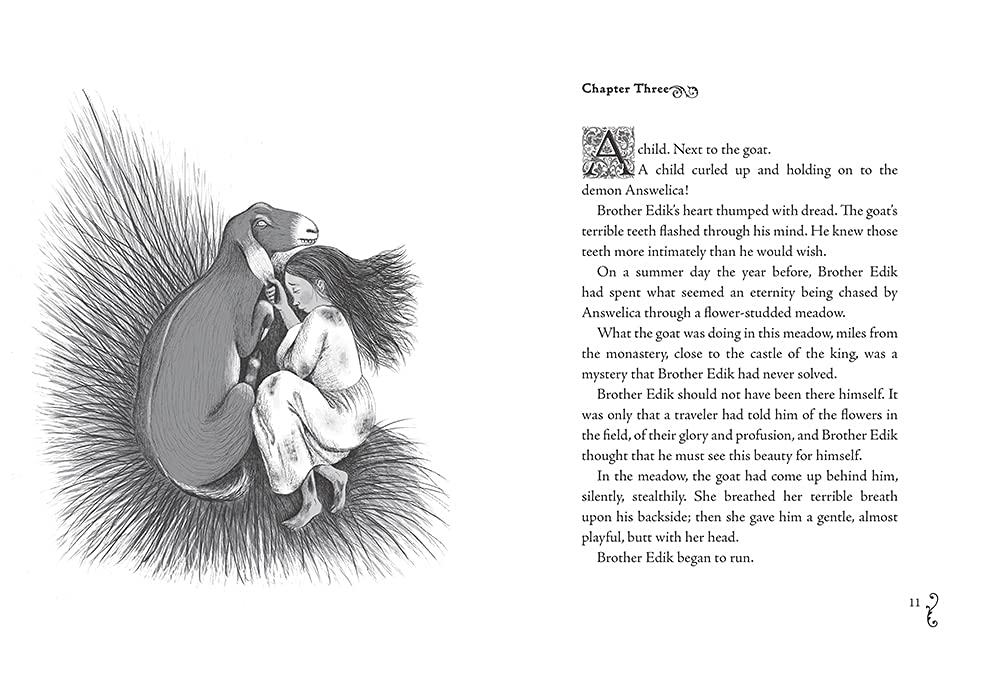
Bianca Schulze: Oh, my gosh. Yes, the goat. The goat is fabulous. You want to meet Answelica to see if she would consider you friend or foe.
Sophie Blackall: Yeah. So normally, as you know, an author and illustrator working on a book don’t really work together. As illustrators, when we receive a manuscript from somebody else, we deal with the art director or the editor. And we rarely have any communication with the authors themselves. That’s sort of across the board unless you have a prior relationship or bring a project together to a publisher. There have been things that I’ve done like that. Like Annie Barrows and I do with the Ivy and Bean series, we now whisper and talk like passing notes in school.
But while Kate and I had met several times over the years, we didn’t know each other very well. But we both felt the great need to communicate early on. And it was so interesting that we had a very similar feeling of a slightly dreamy sense that, in my case, this was a story I’d always known. And in her case, she felt like the drawings had always existed. They came through one by one, and she would see them sent to her by the art director. And she said it just was like each one was sort of fitting a piece into making the full picture, which she felt had always existed. It was just sort of placing the pieces. And that is such a gift to have that response from her because it is such a beautiful story.
I can’t quite imagine writing a story and handing it over and then waiting for somebody else to make pictures to go with it. It’s such a leap of faith. It’s so generous and there’s so much trust there. I can only imagine that they must come back most of the time looking a little different than how you imagined it in your head. So, for Kate to say they came out exactly as she had imagined, they might always be as just how they are. This is Beatryce and all the characters. It was the highest possible compliment.
Bianca Schulze: That’s incredible.
With a picture book where every spread is illustrated, in a novel like this one, there are just scatted black and white illustrations throughout and then your glorious lettering at the beginning of each chapter. How do you decide which parts are going to get illustrated in a novel?
Sophie Blackall: I always think about the person reading it and try to channel what they want to see on the page. And sometimes, it’s a description of something. It’s like, oh, I really want to see what that looks like. Like the inside of the character’s house—he lives inside a tree, and oh, my goodness, of course, you want to see what that house looks like. Or you want to see, when a character is introduced, what they look like. But you also want to see special moments.
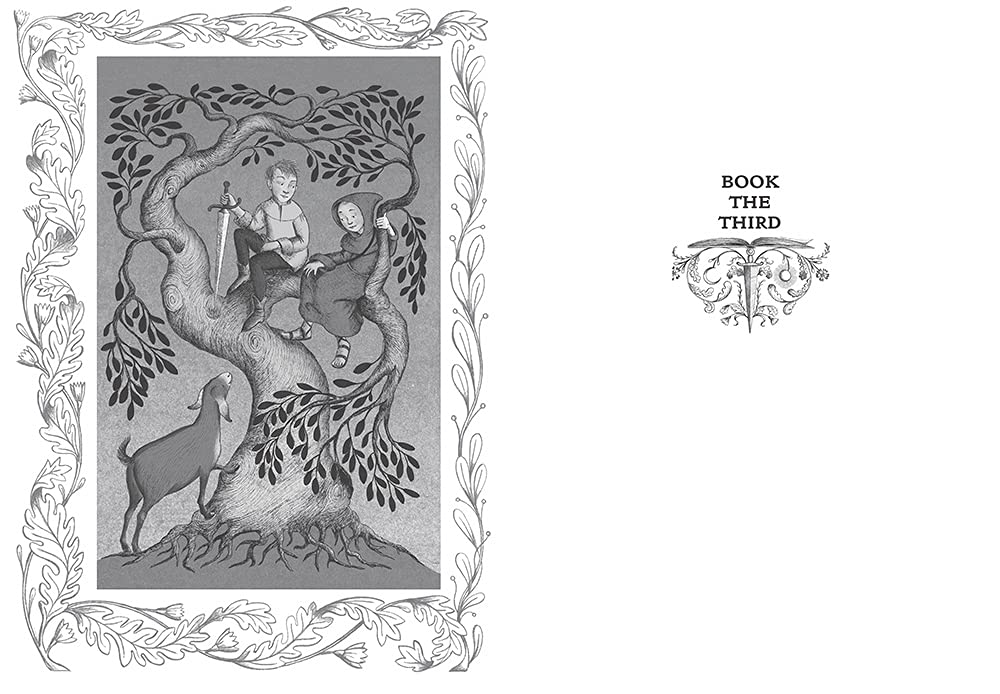
The beauty of making pictures to go with a text you love is that they start to take on a life of their own and don’t simply mirror the text. They add something new. And I think that’s the best and happiest kind of illustrated text is where the drawings and the words support each other and complement each other and talk to one another, but also have their own story to tell.
Bianca Schulze: Ok, so we’re talking a little bit about the process here, so I feel like it’s a perfect time to introduce a new feature to the podcast today. It’s asking people from the book community to share the questions that they have. And we got a few for you, Sophie. And so, I want to share one from Ashley Reese.
Ashley Reese: Hi. This question is for Sophie Blackall. She’s one of my favorite illustrators, and I find her work very inspiring. I am really interested in her process and what that looks like from start to finish. I’d love to know about the mediums she uses and the things that inspire her along the way. Thank you.
Sophie Blackall: Wow. That’s a great question. And we could talk for about three hours about that. And also, you have a lovely voice. It really depends on the book. See what I meant about it? We could have three hours.
If a manuscript comes to me that somebody else has written, then half the work is done. And then I just have to see what the pictures are that form in my head and the best way possible to tell the story and do it justice and then the means to do that.
So, with a story like Beatryce, they were black and white illustrations. And I started with pencil and then I embraced Procreate, which I had never used before. But it was during the pandemic. There were complications with sending original art and things like that. Using Procreate meant that I could do the entire book digitally and then press a button and send the art. I’m very much a hands-on person. I love the tactile experience of making art on paper and using brushes and my hands. And so, this felt slightly like, oh, do I really want to do this? But I have to say I loved it, which doesn’t mean I will always do that. But I felt like it really worked for Beatryce and it really just felt like drawing in pencil. It liberated me in all sorts of ways.
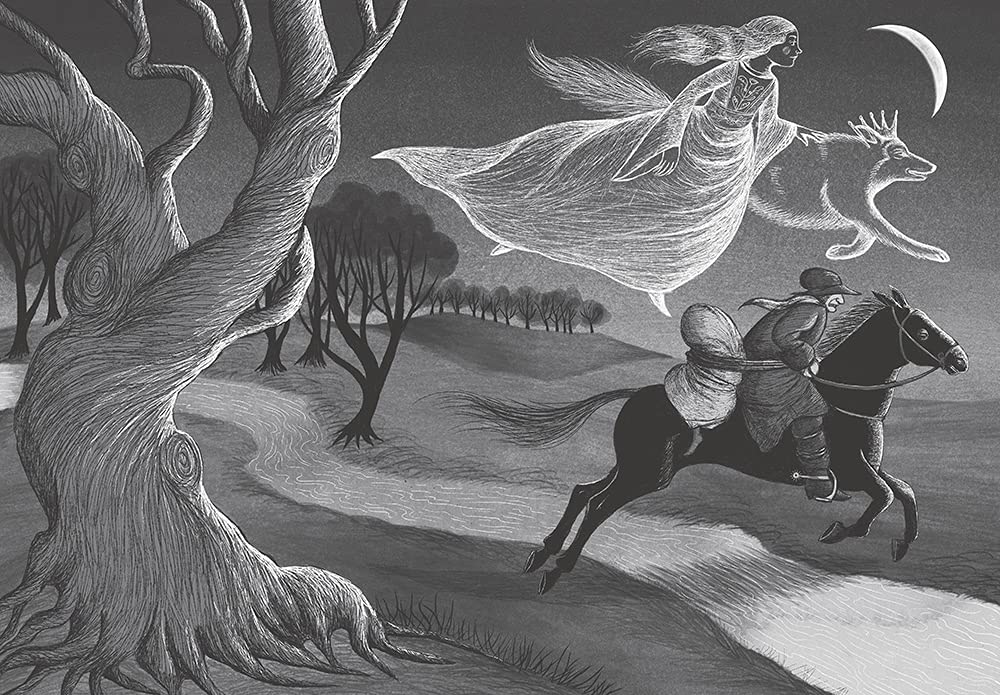
With other books, my goodness, it just depends on what pops into my head. And then the story that needs to be told. For instance, the book that I have on my desk right now is called—it’s a working title—Farmhouse, which was just what we always called it. And I think it has stuck. I think it’s just going to be Farmhouse. It’s a story inspired by a falling-down house on the land where Milkwood is set.
Milkwood will be a retreat for the children’s book community, for artists and writers and editors and librarians and teachers and anybody who cares, podcast people, anyone who cares and is interested in children’s books. But on this land was a falling-down house built in the mid 19th century. It’s a farmhouse. I did a little research and found out that 12 children had been born and raised in this house. It was beyond salvaging. It was falling and dangerous. So, we had to tear it down.
But before then, I went in as many times as I could safely (or not really all that safely) do and salvaged wallpapers and fabric. There were 23 handmade dresses in a pile on the floor in the attic. There was sheet music and old schoolbooks that the kids had had. With all these materials, I started to piece together a story of what I imagined their lives might be like. And then I wrote the story, and then I had just these piles of ephemera. And I thought they were the inspiration for the pictures. And then, bit by bit, I realized they were going to have to be in the pictures. I wanted to actually use them.
So, this book has become quite a collage, which normally I don’t do. But I couldn’t resist. The papers were so beautiful and the fabrics. I thought I could redraw them, but they already exist. And I loved the idea that this book itself and the art that goes with it will be a tribute to the house and the lives of all the people who have stories to tell for a lot longer. And so, it’s become this very, very tangible thing, like the complete opposite of working on Procreate on an iPad with a digital pencil.
So that’s a very long-winded way of saying my process changes with every project that crops up, which makes it very fun and very interesting and the tiniest bit chaotic.
Bianca Schulze: And I think that is the perfect answer from a true artist.
I’m so happy to hear that Milkwood will be the star of a picture book. Why don’t you tell us a little bit more about it? You’re rebuilding and bringing new life to create this retreat for the children’s book community. So, tell us about it.
Sophie Blackall: Yes, it is something I have dreamt about doing for years. And it’s so thrilling to be almost close to the point where we will be able to welcome people to come and share it.
So, it is being built in an old dairy farm in upstate New York in the Catskill Mountains. It’s about three hours from New York City. And right now, we are nearly finished. We’re going to be spending the fall practicing everything and seeing what works and what doesn’t and making sure there’s enough hot water and that the heat works and all of those things and hopefully open in the spring.
When we open, we will be welcoming people—10 or 12 people at a time—for four-day retreat stays, and they will be curated differently. Some will be workshops for people who would love to learn something about making books for children. Maybe they are interested in writing or illustrating, and there will be quite specific kinds of workshops that people can come and do. Or it will be a gathering place for peers. So, people who are already making books—writers and illustrators—who would love to spend some time with their fellow book creators and don’t get to do that as much as they would like. And to just be in the same space together. It is so rewarding.
Many of us work in relative isolation. But I am very fortunate that I have a studio in Brooklyn that I share with other picture book authors and illustrators. And that little community that we have is just incredible. We share our work. We share the other things that happen in our lives—the ups and downs. We share physical resources— we have a fantastic library, a collective library of books, paints, and papers. We have lunch together. And many people have come to visit us and have said: this is so rare what you have here, and I would love to dip into something like that.
So that’s what we’re hoping to offer at Milkwood, a version of that. Where people can come together to eat and drink and walk and talk and think and write and draw and come together in the evenings to sit around a long table and share a meal and talk and share ideas and talk about all different things in the children’s book world that are rapidly changing. And all of those things! It is going to be so exciting.
Bianca Schulze: Well, that sounds like book heaven to me. If there’s anybody that’s listening right now that wanted to find out more or be connected or discover where they can find you and the information, where should they go for it?
Sophie Blackall: Yes. So, on Instagram, we are @milkwoodny and we have a website badly in need of updating, which is https://www.milkwoodfarm.org/. There is a place on the website to sign up for the newsletter, which will be coming shortly, and which will have real facts about when we’re opening and how to book and all those kinds of nuts and bolts. But yes, we’re very excited to welcome everyone to come.
Bianca Schulze: Yay. Okay, well, it’s on my wish list, so I’ll be looking for the right workshop.
I have another question. And this one is actually from a teacher in New South Wales, Australia. But I’ll let her tell you that herself.
A Teacher from N.S.W., Australia: Hi, Sophie. I’m a teacher in New South Wales. I really love inspiring my students to create and illustrate their own work. What I’d love to know is what inspired you as a young child to actually begin creating. Where did you find the love of art?
Bianca Schulze: Isn’t that a great question?
Sophie Blackall: That’s a great question. And so lovely to hear that lovely, beautiful Australian voice. As I said a little bit earlier, I was very lucky to grow up with books. I had a single mum, grew up in South Australia, and she read to us, took us to the library, always made sure we had books around. And because we grew up in the country, my brother and I spent a lot of time climbing trees, and we took books with us, and we would hang out. We’d make a little platform in the trees and hang out there all day. And we’d take snacks, and we’d swap books. We even had a basket on a rope to swap books back and forth.
One of my favorite books at the time was Winnie the Pooh. What I loved about it was—apart from the fantastic, hilarious writing that made you feel like this book was written for you—were Shepherd’s drawings. I used to trace them. We didn’t have a lot of money and didn’t have access to lots of art supplies. But I used to go to the butcher shop on my way home from school every afternoon—and this was the late 70s, so I was just allowed to walk on my own, which kids don’t do that much anymore—I would drop into the butcher shop. They knew me and they would roll up a couple of sheets of paper that they used to wrap the chops and sausages and give it to me for drawing paper. And I used to trace drawings.
I tell kids now that it’s only copying if you’re pretending that they’re your own. But if you’re using it as a way of figuring out how somebody else has built a drawing, how they’ve connected lines, it can be one of the best, most useful tools when you’re learning how to draw. But beyond that, it’s really just looking at as many different kinds of books and art you can be exposed to. And of course, we’re so lucky to have access to basically everything in the world with the Internet that we sure didn’t have when I was a kid. And teachers are so creative—my hat goes off to all of them who have worked through the last two years, which is surely the most challenging of all of our lives, but especially when you’re trying to teach remotely. It’s just incredible that you’re all still standing and also for the families as well.
Just be encouraging and provide materials and to have fun with it, you know, to make sure it’s always fun and not a trial. I have my two kids; one of them loved to draw from the minute they could hold a pen, and one of them had absolutely no interest; it was like blood out of stone. And I was like, really? I have a child who doesn’t want to draw, who finds art like the worst possible trial. And sure, that was a little bit heartbreaking, but that’s kids. Kids find their own joys. I guess it’s our job to step back and let them find the thing that brings them that joy—sometimes easier said than done.
Bianca Schulze: Yes. Oh, my gosh. I love that answer, too. As a child who was also born and raised in Australia, the mention of going to the butchers and the butcher paper brought back lots of memories. So, I’m glad you said that.
OK, so if you loved hearing that Australian voice, you’re going to love hearing this Australian voice. Now, you’ve partly answered the question that’s about to be asked. But this is such a sweet question that I just have to share it, and it’s kind of a two-step question. And I think the second part of this question will be an answer that a lot of people would love to know. So, here we go.
Erica: Hi, Sophie, I’m Erica. And I’m 12 years old and I love sketching and drawing. I would love to know what inspired you to illustrate and know and how you think I could become an illustrator.
Sophie Blackall: Oh, I’m weeping. Oh, Erica. I was about 12 when I decided I wanted to be an illustrator. And I think if you heard before when I was talking about Winnie the Pooh and tracing E.H. Shepard’s drawings and trying to figure out how he puts so much character into those—what seemed like just sketches, you know, they’re just a few lines. When you trace something like that, you realize how simple the drawing is and yet how much personality is in those small drawings. It’s magic, really. But later, when I was about 12, my father subscribed to a magazine called The New Yorker, and they had illustrated covers. Most magazines have photographs on the cover, but The New Yorker has drawings. And I cut off all the covers of his magazines. I didn’t actually ask him. So, he wasn’t thrilled about this when he found out. But I put them all up on my wall like wallpaper, and I would lie in bed and look at them and think, one day, I want to do that. I want to make drawings of books and magazines, and I want to go and live in New York and do it.
So, I think part of your question you asked, how do you become an illustrator? I think part of how you become anything is wanting it enough to do it over and over and over again until you get good at it and to find ways to make that part fun and not to give up if you feel like you’re not doing it well enough or it’s not turning out how you want it to be. Because I think that’s another big part of being an illustrator or an artist.
I’m wondering whether you’ve ever had this experience. A lot of us have, but I do for sure, which is you see the drawing you’re about to make in your head—you see it so clearly and or the painting or whatever you’re going to make. And it’s beautiful. It’s the most beautiful thing you’ve ever done. And then you actually start to try and do it, and it comes out totally differently. When I was a kid, I would do this; I would just want to throw my pencil down and give up because the drawing of the horse that I could see in my head with the galloping hooves and flowing mane came out looking like a weird donkey, basically—not anything against donkeys. I love donkeys, but there are two different ways of going about this one. You can keep drawing and drawing and drawing until you make it like the thing you see in your head. Or you can embrace the thing that comes out on the page that is slightly different from what you saw in your head, but maybe it is pretty cool. And that’s the direction that I decided to go in.
So, I see something in my head. It comes up quite differently on the page, almost like I had nothing to do with it. And I think. Huh? Well, I guess that’s the drawing that wants to come out. And so, I’ve embraced the way that I draw. And I think that’s a big thing for a lot of people and a challenging thing. And I think that embracing the way we draw ourselves makes our drawings more interesting because you can draw in a way that no one else can. So instead of trying to make your horse look like a photograph of a horse—which if anybody works hard enough, they can do (and you may not even want to draw a horse, but I’m just using a horse as an example)—you could draw your own Erica horse. That would be far more interesting. So that is my advice to you.
Bianca Schulze: That’s great. I just want to thank Erica for that awesome question because I feel like, you know, from a 12-year-old, that’s an excellent question. But it’s a question that a lot of adults would like to know, too. So, thanks for asking it, Erica, because we all loved that answer from Sophie.
OK, so there’s a question I ask everybody at the end of the podcast episodes, and it’s: To be a writer, they say you need to be a reader first. Was there a pivotal moment in which you considered yourself a reader?
Sophie Blackall: You know, it’s so interesting; I was talking with a couple of teachers the other day who teach reading to kids, and they were talking about all the different methods and phonics, and it kind of made my head spin. And it suddenly occurred to me how many of us actually remember learning to read. And then I thought, do I even remember my kids learning to read?
I think it differs very much whether you find reading challenging and whether it’s a lot of work to make sense of it. And that moment, that pivotal moment when you suddenly do make sense of it, and the letters all form themselves into words and words that have meaning and words that tell stories, that comes more easily to some people than it does to others. And I guess I was one of the people for whom it comes easily. Partly I had an older brother who was already reading, and I was just desperate to do everything he wanted to do. And I think there have been lots of studies that show this is common with younger siblings, that they sometimes do things more quickly than the older ones because they just want to be in on the fun.
And so, for me, I don’t remember learning my letters. I don’t remember putting them together, really. And I don’t remember the moment where it all made sense, but I know how much I wanted it. And then I remembered the joy of being able to do it on my own. And in those books, I used to go to thrift stores and buy books with my pocket money. So, I bought all sorts of really funny, old-fashioned kinds of books. But Winnie the Pooh was, I think, the moment where I thought not only do I want to be a reader, but maybe I also want to be a writer because that story breaks the fourth wall. It talks to you, the reader, and invites you into this world while also reminding you now and then that it is also a book. And there’s magic to that.
Bianca Schulze: Sophie, you are so wise and wonderful and worldly, and I have loved this conversation, and I have my fingers crossed that we’ll get to do this again sometime in the future.
Sophie Blackall: I would love that. It’s always a pleasure to chat with you, Bianca, and thank you for doing what you do and bringing us all these different voices, telling stories, and supporting reading, which is so wonderful and important. And I hope we get to meet live and in person.
Bianca Schulze: That would be wonderful, and preferably for me at Milkwood.
Sophie Blackall: I would love that.
About the Books

Negative Cat
Written and Illustrated by Sophie Blackall
Ages 4-8 | 32 Pages
Publisher: Nancy Paulsen Books | ISBN-13: 9780399257193
Publisher’s Synopsis: When a boy is FINALLY allowed to get a cat, he has no doubts about which one to bring home from the shelter. But Max the cat isn’t quite what the family expected. He shuns the toy mouse, couldn’t care less about the hand-knitted sweater, and spends most of his time facing the wall. One by one, the family gives up on Max, but the boy loves his negative cat so much, he’ll do anything to keep him. Even the thing he dreads most: practicing his reading. Which, as it turns out, makes everything positive!
Buy the Book

The Beatryce Prophecy
Written by Kate DiCamillo
Illustrated by Sophie Blackall
Ages 8-12 | 256 Pages
Publisher: Candlewick | ISBN-13: 9781536213614
Publisher’s Synopsis: From two-time Newbery Medalist Kate DiCamillo and two-time Caldecott Medalist Sophie Blackall comes a fantastical meditation on fate, love, and the power of words to spell the world.
We shall all, in the end, be led to where we belong. We shall all, in the end, find our way home.
In a time of war, a mysterious child appears at the monastery of the Order of the Chronicles of Sorrowing. Gentle Brother Edik finds the girl, Beatryce, curled in a stall, wracked with fever, coated in dirt and blood, and holding fast to the ear of Answelica the goat. As the monk nurses Beatryce to health, he uncovers her dangerous secret, one that imperils them all—for the king of the land seeks just such a girl, and Brother Edik, who penned the prophecy himself, knows why.
And so it is that a girl with a head full of stories—powerful tales-within-the-tale of queens and kings, mermaids and wolves—ventures into a dark wood in search of the castle of one who wishes her dead. But Beatryce knows that, should she lose her way, those who love her—a wild-eyed monk, a man who had once been king, a boy with a terrible sword, and a goat with a head as hard as stone—will never give up searching for her, and to know this is to know everything.
With its timeless themes, unforgettable cast, and magical medieval setting, Kate DiCamillo’s lyrical tale, paired with resonant black-and-white illustrations by Caldecott Medalist Sophie Blackall, is a true collaboration between masters.
Buy the Book
About the Author-Illustrator
Sophie Blackall is the two-time Caldecott Medal-winning illustrator of numerous picture books, including The Baby Tree, Hello Lighthouse, Finding Winnie (by Lindsay Mattick), A Voyage in the Clouds (by Matthew Olshan), Pecan Pie Baby (by Jacqueline Woodson), Big Red Lollipop (by Rukhsana Khan), and the Ivy and Bean series (by Annie Barrows). Her many honors include a BCCB Blue Ribbon, Ezra Jack Keats New Illustrator Award, Society of Illustrators Founders Award, and Charlotte Zolotow Honor. Sophie’s art has also been part of the NYC MTA’s “Arts for Transit” program. She lives in Brooklyn, New York.
For more information, visit https://www.sophieblackall.com/.
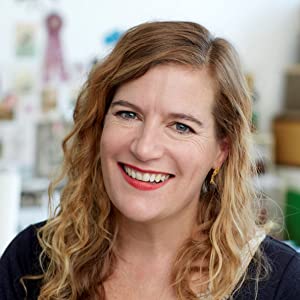
Thank you for listening to the Growing Readers Podcast episode: Sophie Blackall Discusses Negative Cat and The Beatryce Prophecy. For the latest episodes from The Growing Readers Podcast, Follow Now on Spotify. For similar books and articles, you can check out all of our content tagged with Cats, Kate DiCamillo, Reading Tips, and Sophie Blackall.

